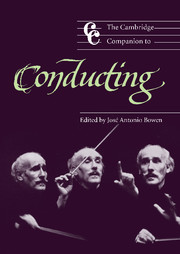Book contents
15 - The conductor as artistic director
from Part III - Issues
Published online by Cambridge University Press: 28 September 2011
Summary
In a famous 1941 wartime photograph (Fig. 15.1) Sir Henry Wood stands amid the ruins of London's Queen's Hall, atop the rubble and chaos of what had once been his artistic domain. The image is of desolation, but also defiance in the face of a Luftwaffe raid. Wood's biographer, Arthur Jacobs, has pointed out that two similarly earnest BBC officials were airbrushed out of the original. Propaganda required the symbolism of the artist's civilizing vision amidst its destruction by the nefarious Nazis. Wood's hegemony over the Proms was drawing to a close. Although he was never officially artistic director, his association dated back to their inception in 1895. He died three years later, having seen his famous music festival transferred to the Royal Albert Hall where it prospers beyond his wildest dreams.
By way of contrast, in 1983 Simon Rattle was captured on film inspecting the building site of Symphony Hall, in Birmingham, with tousled hair barely suppressed beneath the regulation hard hat. Rattle was in the middle of an astonishingly successful period as Principal Conductor and Music Director of the City of Birmingham Symphony Orchestra (his title changed during his tenure). Not entirely coincidentally, the last two decades of the twentieth century saw the rebirth of Birmingham as an international city. 1960s urban planners had wreaked almost as much havoc as the Luftwaffe did in wartime. Concrete was universally employed as the material of the moment as the city was rebuilt. Paradoxically, musique concrète was successfully featured amongst Rattle’s programming as he took the CBSO around the world for over two decades, winning renown for Birmingham and personally embodying the renaissance of its reputation.
- Type
- Chapter
- Information
- The Cambridge Companion to Conducting , pp. 203 - 219Publisher: Cambridge University PressPrint publication year: 2003
- 2
- Cited by



